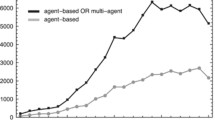Abstract
Many agent-based models, use standard distributions in several steps of the design: configuring the initial conditions of simulations, distributing objects spatially, and determining exogenous factors or aspects of the agents’ behaviour. An alternative approach that is growing in popularity is data-driven agent-based simulation. This paper encourages modellers to continue this trend, discussing some guidelines for finding suitable data and feeding models with it. In addition it proposes to merge the principles of microsimulation into the classical logic of agent-based simulation, adapting it to the data-driven approach. A case study comparing the two approaches is provided.
Access this chapter
Tax calculation will be finalised at checkout
Purchases are for personal use only
Similar content being viewed by others
References
Batty M (2001) Agent-based pedestrian modeling. Environ Plann B Plann Des 28:321–326
Boero R, Squazzoni F (2005) Does empirical embeddedness matter? Methodological issues on agent-based models for analytical social science. J Artif Soc Soc Simulat 8(4)6. http://jasss.soc.surrey.ac.uk/8/4/6.html
Dean JS, Gumerman GJ, Epstein JM, Axtell RL, Swedlund AC, Parker MT, McCarroll S (2000) Understanding Anasazi culture change through agent-based modeling. Oxford University Press, Oxford, pp 179–205
Edmonds B, Moss S (2005) From KISS to KIDS – an ‘anti-simplistic’ modeling approach. http://hdl.handle.net/2173/13039
Galán JM, López-Paredes A, Olmo R (2010) An agent based model for domestic water management in Valladolid metropolitan area. Water Resour Res 45(5):w05401
Gatherer D (2006) Comparison of eurovision song contest simulation with actual results reveals shifting patterns of collusive voting alliances. J Artif Soc Soc Simulat 9(2)1. http://jasss.soc.surrey.ac.uk/9/2/1.html
Geller A (2008) Power, resources and violence in contemporary conflict: artificial evidence. In: Second world congress of social simulation, Washington, DC
Gilbert N (2008) Researching social life, 3rd edn. SAGE Ltd., London
Gilbert N, Troitzsch KG (1999) Simulation for the social scientist, 1st edn. Open University Press, UK
Gupta A, Kapur V (2000) Microsimulation in government policy and forecasting. North Holland, Amsterdam
Hassan S, Antunes L, Arroyo M (2008) Deepening the demographic mechanisms in a data-driven social simulation of moral values evolution. In: MABS 2008: multi-agent-based simulation. LNAI: Lecture notes in artificial intelligence. Springer, Lisbon
Hassan S, Antunes L, Pavón J, Gilbert N (2008) Stepping on earth: a roadmap for data-driven agent-based modelling. In Proceedings of the fifth conference of the European social simulation association (ESSA08), Brescia, Italy
Hassan S, Pavón J, Arroyo M, Leon C (2007) Agent based simulation framework for quantitative and qualitative social research: statistics and natural language generation. In: Amblard F (ed) ESSA’07: fourth conference of the European social simulation association, Toulouse, France, pp 697–707
Hedström P (2005) Dissecting the social: on the principles of analytical sociology. Cambridge University Press, Cambridge
Nicolaisen J, Petrov V, Tesfatsion L (2001) Market power and efficiency in a computational electricity market with discriminatory double-auction pricing. IEEE Trans Evol Comput 5:504–523
Pavón J, Arroyo M, Hassan S, Sansores C (2008) Agent-based modelling and simulation for the analysis of social patterns. Pattern Recogn Lett 29:1039–1048
Taraborelli D, Roth C, Gilbert N (2008) Measuring wiki viability (ii). Towards a standard framework for tracking content-based online communities (white paper)
Yang L, Gilbert N (2007) Getting away from numbers: using qualitative observation for agent-based modelling. In: Amblard F (ed) ESSA’07: fourth conference of the European social simulation association, Toulouse, France, pp 205–214
Acknowledgments
We acknowledge support from the projects: NEMO: Network Models, Governance and R&D collaboration networks funded by the European Commission Sixth Framework Programme – Information Society and Technologies – Citizens and Governance in the Knowledge Based Society, and Agent-based Modelling and Simulation of Complex Social Systems (SiCoSSys), supported by Spanish Council for Science and Innovation, with grant TIN2008-06464-C03-01. We would also like to thank the anonymous reviewers for their valuable comments.
Author information
Authors and Affiliations
Corresponding author
Editor information
Editors and Affiliations
Rights and permissions
Copyright information
© 2010 Springer
About this paper
Cite this paper
Hassan, S., Pavón, J., Antunes, L., Gilbert, N. (2010). Injecting Data into Agent-Based Simulation. In: Takadama, K., Cioffi-Revilla, C., Deffuant, G. (eds) Simulating Interacting Agents and Social Phenomena. Agent-Based Social Systems, vol 7. Springer, Tokyo. https://doi.org/10.1007/978-4-431-99781-8_13
Download citation
DOI: https://doi.org/10.1007/978-4-431-99781-8_13
Publisher Name: Springer, Tokyo
Print ISBN: 978-4-431-99780-1
Online ISBN: 978-4-431-99781-8
eBook Packages: Computer ScienceComputer Science (R0)




